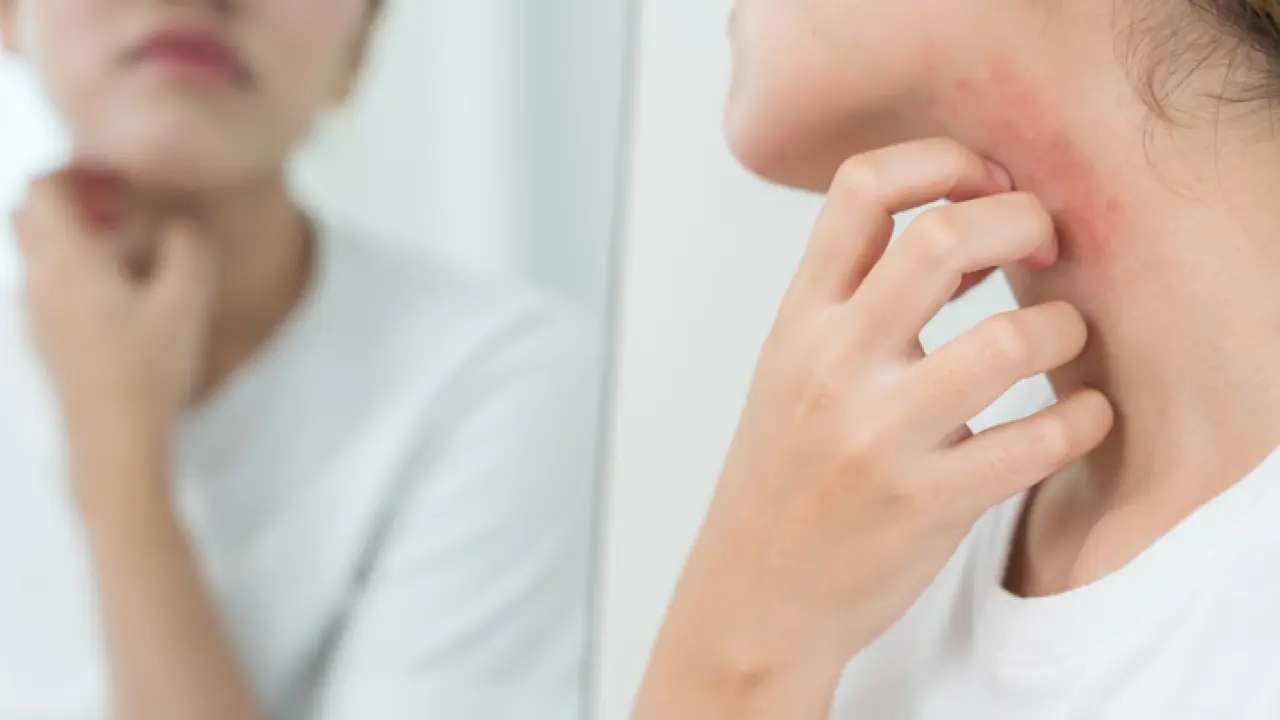Dealing with an itchy, red, scaly rash can be incredibly frustrating, especially when you’re unsure what’s causing it. Two of the most commonly confused skin conditions are eczema and ringworm – and while they may look similar at first glance, they’re completely different conditions that require different approaches.
Getting the right identification is crucial because using the wrong treatment can actually make your symptoms worse or delay healing. This comprehensive guide will help you understand the key differences between eczema and ringworm, recognize important warning signs, and know when it’s time to consult a healthcare professional.
Important Note: This information is for educational purposes only and should not replace professional medical advice. Always consult with a healthcare provider or dermatologist for proper diagnosis and treatment recommendations.
Understanding the Basics: What Are Eczema and Ringworm?
Eczema (Atopic Dermatitis)
Eczema is a chronic inflammatory skin condition that affects millions of people worldwide. According to the National Eczema Association, it’s a non-contagious condition often linked to genetics and immune system function. People with eczema typically have sensitive skin that reacts to various triggers in their environment.
Ringworm (Tinea)
Despite its name, ringworm isn’t caused by worms at all. It’s actually a fungal infection caused by dermatophytes – microscopic fungi that feed on keratin found in skin, hair, and nails. The Centers for Disease Control and Prevention (CDC) notes that ringworm is highly contagious and can spread through direct contact with infected people, animals, or contaminated surfaces.
Key Differences: How to Tell Them Apart

Visual Appearance and Shape
Ringworm Characteristics:
- Distinctive circular or oval patches with well-defined borders
- Raised, scaly edges that are often red or darker than surrounding skin
- Clear or less affected skin in the center, creating the characteristic “ring” appearance
- Individual patches that may grow larger over time
- Often asymmetrical distribution on the body
Eczema Characteristics:
- Irregular, poorly defined borders
- Patches can be various shapes and sizes
- Uniform redness and inflammation throughout the affected area
- May appear thickened or leathery from chronic scratching
- Often symmetrical, appearing on both sides of the body
Common Locations
Where Ringworm Typically Appears:
- Can occur anywhere on the body
- Common sites include arms, legs, torso, and face
- May appear as isolated patches
- Can affect the scalp (tinea capitis) or feet (athlete’s foot)
Where Eczema Commonly Develops:
- Flexural areas (elbow creases, behind knees)
- Neck, wrists, and ankles
- Face and eyelids (especially in children)
- Hands and fingers
- Typically appears in predictable patterns
Symptoms and Sensations
Ringworm Symptoms:
- Itching (ranging from mild to intense)
- Red, scaly patches with raised borders
- Hair loss if affecting the scalp
- Brittle or discolored nails if affecting nail beds
- Burning sensation in some cases
Eczema Symptoms:
- Intense itching, especially at night
- Dry, sensitive skin
- Red or brownish-gray patches
- Small, raised bumps that may leak fluid when scratched
- Raw, sensitive, swollen skin from scratching
The Science Behind Each Condition
What Causes Ringworm?
Ringworm is caused by dermatophyte fungi that thrive in warm, moist environments. These fungi can survive on surfaces for extended periods, making transmission relatively easy. Risk factors include:
- Close contact with infected individuals or animals (especially house pets)
- Sharing personal items like towels, clothing, or sports equipment
- Walking barefoot in public areas (pools, locker rooms, showers)
- Having a compromised immune system
- Living in hot, humid climates
What Triggers Eczema?

Eczema is a complex condition involving genetic predisposition and environmental factors. The National Institute of Arthritis and Musculoskeletal and Skin Diseases identifies several common triggers:
- Allergens (dust mites, pet dander, pollen)
- Irritants (harsh soaps, detergents, fragrances)
- Stress and emotional factors
- Weather changes (especially dry, cold conditions)
- Hormonal fluctuations
- Certain foods (in some individuals)
When to Seek Professional Medical Care
While some mild skin conditions can be managed at home, certain situations require professional medical evaluation:
See a Healthcare Provider If You Experience:
- Symptoms that worsen despite home care
- Signs of bacterial infection (pus, increasing redness, red streaking)
- Fever accompanying skin symptoms
- Widespread rash covering large areas of the body
- Symptoms affecting the scalp or nails
- Uncertainty about the diagnosis
- Symptoms that significantly impact daily activities or sleep
Emergency Care May Be Needed If:
- You develop signs of severe allergic reaction
- The affected area becomes extremely painful
- You experience fever with rapidly spreading rash
Treatment Approaches: Understanding Your Options
Disclaimer: The following information is educational only. Always consult healthcare professionals before starting any treatment.
Curability
Depending on what you may be experiencing, you might be asking yourself, “Is this curable?”
- Ringworm: It responds to and can be cured by antifungal treatments.
- Eczema: It’s a chronic condition that can’t be cured, but symptoms can be managed with topical treatments to control flare-ups. Some might even say that certain diets or dietary restrictions can also help, but that would require your own personal journey to discover if that is the case.
Ringworm Management

Since ringworm is a fungal infection, it typically requires antifungal treatment. The American Academy of Dermatology notes that proper treatment can effectively eliminate the infection:
- Topical antifungals: Often the first line of treatment for body ringworm
- Oral medications: May be necessary for scalp or nail infections
- Proper hygiene: Essential for preventing spread and reinfection
For those managing ringworm, some people turn to over-the-counter antifungal ointments. terrasil® Ringworm Treatment MAX, which contains an FDA-recognized antifungal, 1% clotrimazole, and is formulated to relieve itching, burning, and redness associated with ringworm while supporting skin repair with its patented Activated Minerals® blend.‡ Consistent use, paired with good hygiene habits, is important for results.
Eczema Management

Eczema is a chronic condition that requires ongoing management rather than a cure:
- Moisturizing: Daily application of fragrance-free moisturizers
- Trigger avoidance: Identifying and avoiding personal triggers
- Topical treatments: As recommended by healthcare providers.
- Lifestyle modifications: Stress management, appropriate clothing choices
When flare-ups strike, many people look for steroid-free ways to calm irritation. terrasil® Eczema & Psoriasis Severe Outbreak Ointment is designed to soothe itching, redness, and discomfort with natural botanicals like Comfrey and Thuja, along with Activated Minerals®.‡ Used with the terrasil® Eczema Cleansing Soap Bar, which gently cleanses with calendula, coconut oil, and shea butter, this routine can help support skin comfort and barrier health.
Prevention Strategies: Stopping Problems Before They Start
Preventing Ringworm: Your Defense Game Plan

Keep skin clean and dry – this is your first line of defense against fungal infections. Fungi absolutely love warm, moist environments, so after workouts, swimming, or any activity that makes you sweat, shower as soon as possible and dry off thoroughly². Pay special attention to areas where skin touches skin, like between your toes, under your arms, and in the groin area. If you can’t shower immediately, at least change out of sweaty clothes and use antifungal powder in problem areas.
Avoid sharing personal items because ringworm spreads incredibly easily through contaminated objects. This means keeping your towels, razors, hairbrushes, hats, and clothing to yourself². Even seemingly innocent items like yoga mats, sports equipment, or hotel bedding can harbor fungal spores. If you must share equipment (like at a gym), wipe it down before and after use with antifungal disinfectant.
Wear protective footwear in public areas because walking barefoot in locker rooms, pool decks, communal showers, and hotel rooms is basically like rolling out the welcome mat for fungi². Flip-flops or shower shoes aren’t just about avoiding gross stuff – they’re your barrier against picking up fungal infections. Even in seemingly clean areas, fungi can survive on surfaces for months.
Regular handwashing is crucial, especially after touching animals, using gym equipment, or being in public spaces. Fungi can live under your fingernails and spread to other parts of your body when you scratch or touch your skin². Use soap and warm water, and don’t forget to clean under your nails.
Keep pets healthy and get them checked regularly for signs of ringworm, especially if they go outdoors or interact with other animals². Cats are notorious carriers and might not show obvious symptoms while still being contagious. If your pet has patchy hair loss, scaly skin, or circular lesions, get them to a vet promptly to prevent transmission to your family.
Managing Eczema Flare-ups: Your Long-term Strategy

Maintain a consistent skincare routine because eczema-prone skin needs constant TLC, not just attention during flare-ups. This means moisturizing at least twice daily with thick, fragrance-free products, using gentle cleansers that don’t strip your skin’s natural oils, and being consistent even when your skin looks good⁴. This is the perfect time to apply terrasil® Eczema & Psoriasis Severe Outbreak Ointment, for example. Unlike standard lotions, its ointment formula delivers a longer-lasting protective barrier to help lock in moisture and soothe your skin throughout the day.
Keep skin moisturized year-round, but pay extra attention during winter months when indoor heating and cold outdoor air can wreak havoc on sensitive skin⁵. Use a humidifier in your bedroom, avoid hot showers (lukewarm is better), and apply our terrasil® Eczema & Psoriasis Severe Outbreak Ointment or other moisturizer while your skin is still damp from bathing to lock in hydration.
Use gentle, fragrance-free products throughout your home, not just in your skincare routine. This includes laundry detergents, fabric softeners, household cleaners, and even the soap other family members use⁵. Fragrances and harsh chemicals can trigger flare-ups even through indirect contact, like sleeping on sheets washed with scented detergent or hugging someone wearing strong perfume.
Identify and avoid personal triggers by keeping a detailed eczema diary. Note what you ate, what products you used, your stress levels, the weather, and how your skin responded⁵. Patterns might not be obvious at first, but over time you’ll start to see connections. Some people find that certain foods trigger flares, while others are more sensitive to environmental factors like pollen or dust mites.
Manage stress levels because the connection between stress and eczema is real and powerful. Chronic stress can weaken your immune system and increase inflammation throughout your body, making flare-ups more likely and more severe⁵. This might mean regular exercise, meditation, therapy, or whatever stress-reduction techniques work for you. It’s not just about feeling better mentally – it’s about keeping your skin healthy too.
Red Flags: When Home Diagnosis Isn’t Enough
Self-diagnosis can sometimes lead to inappropriate treatment, which may worsen symptoms or delay proper healing. Professional evaluation is particularly important when:
- Symptoms don’t improve with appropriate care
- The rash spreads rapidly
- Multiple family members develop similar symptoms
- You have underlying health conditions that affect immune function
The Importance of Accurate Diagnosis
Misidentifying your skin condition can have significant consequences. Using the wrong type of treatment – such as applying steroid creams to a fungal infection – can actually make the condition worse and harder to treat later.
Healthcare providers have access to diagnostic tools and expertise that can provide definitive answers, including:
- Clinical examination techniques
- Laboratory tests (such as KOH preparation for fungal detection)
- Patch testing for allergen identification
- Dermoscopy for detailed skin examination
Frequently Asked Questions
The Bottom Line: When in Doubt, See a Professional
While understanding the differences between eczema and ringworm is valuable for educational purposes, professional medical evaluation should be your first step when dealing with any persistent or concerning skin condition.
The Reality Check:
- Dermatologists spend years training to diagnose skin conditions accurately
- Even they sometimes need diagnostic tests to be certain
- Self-diagnosis based on internet research, while tempting, often leads to treatment delays and complications
- The cost of a medical visit is typically far less than weeks of wrong treatments and potential complications
What to Expect at Your Visit: Your healthcare provider will likely:
- Take a detailed history of your symptoms and potential exposures
- Perform a thorough examination of the affected areas
- Potentially conduct simple in-office tests for immediate results
- Provide you with a clear diagnosis and treatment plan
- Give you specific instructions for prevention and follow-up care
Remember: Both eczema and ringworm are completely treatable conditions. Getting the right diagnosis from the start puts you on the fastest path to relief and prevents potential complications or spread to others.
Sources and References
- National Eczema Association. “What is Eczema?” Available at: nationaleczema.org
- Centers for Disease Control and Prevention. “Fungal Diseases: Ringworm.” Available at: cdc.gov/fungal/diseases/ringworm
- American Academy of Dermatology. “Ringworm: Overview.” Available at: aad.org
- National Institute of Arthritis and Musculoskeletal and Skin Diseases. “Atopic Dermatitis (Eczema).” Available at: niams.nih.gov
- National Institute of Arthritis and Musculoskeletal and Skin Diseases. “Atopic Dermatitis: Causes and Risk Factors.” Available at: niams.nih.gov
- Mayo Clinic. “Ringworm (body): Symptoms and Causes.” Available at: mayoclinic.org
- American Academy of Dermatology. “Eczema: Diagnosis and Treatment.” Available at: aad.org
- Cleveland Clinic. “Dermatophyte Infections.” Available at: clevelandclinic.org
Medical Review: This content has been developed for educational purposes and should be reviewed by qualified healthcare professionals. Individual medical situations may vary.






